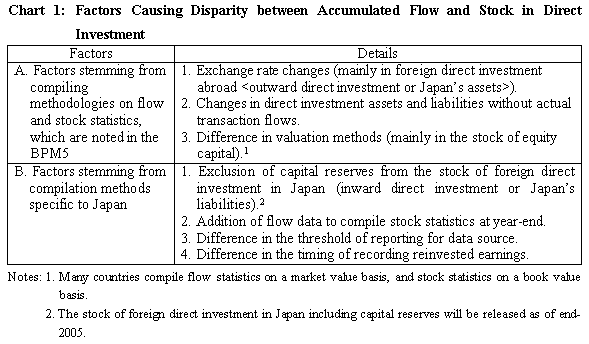Differences in Treatment of Direct Investment in the Balance of Payments Statistics and the International Investment Position*1
December 2003
Maiko Wada*2
Kouichirou Oonishi*3
Papers in the Bank of Japan Working Paper Series are circulated in order to stimulate discussion and comments. Views expressed are those of the authors and do not necessarily reflect those of the Bank.
If you have any comments or questions on the working paper series, please contact the authors.
Click on wp03e06.pdf (151KB) to download the full text.
- *1 We would like to express thanks to our colleagues at the Bank of Japan's (hereafter, the Bank) International Department and Research and Statistics Department for their helpful comments. Views expressed in this paper are, however, solely those of the authors and not those of the Bank, the International Department, or the Research and Statistics Department. The original Japanese-language version of this report was released on August 21, 2003.
- *2 International Department, E-mail: maiko.wada@boj.or.jp
- *3 International Department, E-mail: kouichirou.oonishi@boj.or.jp
Summary
Direct investment refers to a long-term capital transaction across borders that consequently gives the direct investor an effective voice in the management of the direct investment enterprise. According to the Balance of Payments Manual, fifth edition (hereafter, the BPM5), an international standard for compiling the Balance of Payments (BOP) statistics, direct investment is basically defined as an international capital transaction made by a direct investor that has ownership of 10 percent or more in the direct investment enterprise. Major countries including Japan compile and release figures for transaction flows in direct investment in the BOP (flow statistics)and the stock at year-end of direct investment, a major component of the International Investment Position (IIP; stock statistics), as noted in the BPM5.
Direct investment statistics are often regarded as a significant reference in formulating economic policies or evaluating policy effects, due to their large impact on a nation's economy. Direct investment statistics have gained more attention in Japan, following Prime Minister Koizumi's proposal in his fiscal 2003 policy speech to double the stock of direct investment to Japan within the next five years, in order to revitalize the economy.2
Some statistical users, however, may feel confusion when analyzing direct investment statistics because there is disparity between accumulated flow and stock. This disparity comes from differences in valuation methods, significant differences in compilation methods, and data coverage caused by constraints in data sources, etc.
Various factors cause the disparity between accumulated flow and stock, and can be classified into the following two groups: (1) disparity caused inevitably in the process of compilation of flow and stock statistics as noted in the BPM5, and (2) that stemming from compilation methods specific to Japan (Chart 1).

For statistical users, it is desirable to have no significant disparity between accumulated flow and stock. Statistics compilers should therefore further consider harmonization of flow and stock statistics. The following two points should be considered first in reviewing the compilation methods specific to Japan.
- (1) Reviewing the method of adding flow data from April to December on fiscal year-end (end of March) stock (B.2. in Chart 1).
- (2) Supplementing data for stock statistics that are below the threshold of the present reporting system (B.3 in Chart 1).
On the other hand, in the international project for updating the BPM5, the compiling methodologies for flow and stock statistics are under review. The majority view on this issue is that data for stock statistics should be recorded on a market value basis. Of concern is the valuation of nonlisted stocks, for which there are two possible methods. The first of these is to use the ratio of "Market value to book value," calculated using the prices of individual listed stocks or stock price indices, while the second is to use the book value instead. It is considered desirable in this paper to use the book value basis for nonlisted stocks rather than individual estimates to improve international comparability. The reason for this is that experimental studies are unsatisfactory in terms of properly reflecting liquidity risk premiums (reduction in value due to low marketability and insufficient disclosure) to the estimated market values.
In the field of statistics, concerned parties, particularly the International Monetary Fund (IMF), are becoming more conscious of "data quality." The IMF has formulated the "Data Quality Assessment Framework (DQAF)," which provides assessment frameworks for the BOP and IIP. "Data quality" implies not only accuracy and reliability but also concepts such as methodological soundness, as well as serviceability and accessibility for statistical users. Efforts should be made, concurrent with the explanation of the actual transaction practice in Japan, to actively participate in and contribute to discussions concerning updating the BPM5 so that more appropriate recording principles will be adopted. Meanwhile, compilation methods in Japan should be continuously reviewed in order to improve the quality of statistics, while giving due consideration to the reporting burden.
- 2 "Fiscal 2003 Economic Outlook and Basic Stance for Economic and Fiscal Management."
